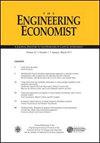用累积总和(CUSUM)控制图重新平衡指数跟踪投资组合
IF 1
4区 经济学
Q4 BUSINESS
引用次数: 3
摘要
摘要在本研究中,我们使用累积和(CUSUM)控制图方法来调节指数跟踪投资组合随时间的更新,因为我们试图使再平衡决策成为投资组合选择问题的内生决策。我们使用了来自两个股市(美国和巴西)的数据,并估计了基于CUSUM的投资组合以及使用固定再平衡时间窗口的投资组合。我们还提供了与指数加权移动平均(EWMA)控制图方法的比较。我们的研究结果表明了CUSUM的适用性,在动态条件下,当跟踪性能较差时(通常在市场波动较大的时期),我们有更多的投资组合更新,而当跟踪性能有效时,我们有更少的更新。本文章由计算机程序翻译,如有差异,请以英文原文为准。
Rebalancing index tracking portfolios with cumulative sum (CUSUM) control charts
Abstract In this study, we use the cumulative sum (CUSUM) control chart methodology to regulate index tracking portfolio updates over time, as we seek to make the rebalancing decision endogenous to the portfolio selection problem. We use data from two stock markets (United States and Brazil), and we estimate CUSUM based portfolios as well as portfolios using fixed rebalancing time windows. We also provide a comparison with the exponentially weighted moving average (EWMA) control chart methodology. Our findings show the suitability of CUSUM, in a dynamic condition in which we have more portfolio updates when tracking performance is poor (usually during periods when markets have more volatility) and lower updates when tracking performance is effective.
求助全文
通过发布文献求助,成功后即可免费获取论文全文。
去求助
来源期刊

Engineering Economist
ENGINEERING, INDUSTRIAL-OPERATIONS RESEARCH & MANAGEMENT SCIENCE
CiteScore
2.00
自引率
0.00%
发文量
14
审稿时长
>12 weeks
期刊介绍:
The Engineering Economist is a refereed journal published jointly by the Engineering Economy Division of the American Society of Engineering Education (ASEE) and the Institute of Industrial and Systems Engineers (IISE). The journal publishes articles, case studies, surveys, and book and software reviews that represent original research, current practice, and teaching involving problems of capital investment.
The journal seeks submissions in a number of areas, including, but not limited to: capital investment analysis, financial risk management, cost estimation and accounting, cost of capital, design economics, economic decision analysis, engineering economy education, research and development, and the analysis of public policy when it is relevant to the economic investment decisions made by engineers and technology managers.
 求助内容:
求助内容: 应助结果提醒方式:
应助结果提醒方式:


